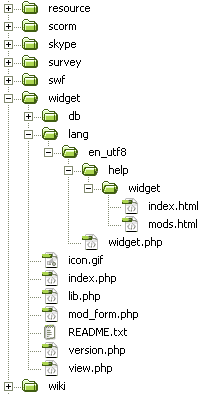Note: This page is a work-in-progress. Feedback and suggested improvements are welcome. Please join the discussion on moodle.org or use the page comments.
How to Begin the Creation of a New Module
- Choose a name for your module. Take care: no capital letter and no numbers in the name. In this example it will be choosen: "widget".
- Use a good text editor to perform a multi-file find/replace to change all occurrences of "newmodule" in each file with the name of your own module.
- Change the name of the folder containing your newly-created module to "widget".
- Change the name of file "widget/lang/en_utf8/newmodule.php" to "widget.php".
- Put your newly-created widget folder in moodle/mod/.
- Visit the Moodle "Notifications" page (in the Moodle->Site Administration block) to trigger installation of your module.
- Follow the instructions on the screen.
Some Basic Regulation for the Beginner PHP Developer
You will probably want to use this set of basic commands:
- require
- require_once
- include
- include_once
Take in mind the difference between them.
- The difference between require and include is: require produces a fatal E_ERROR level error which halts execution if the specified file cannot be accessed, while include produces a warning (E_WARNING) which does not halt execution if the specified file cannot be accessed
- The difference between require and require_once is: require_once checks if the file has been included and does not include it again if it has
- The difference between include and include_once is: include_once checks if the file has been included and does not include it again if it has
Use only xxx to call libraries and use only xxx to include snippets of code written to different files.
Remember:
- redirect moves the execution of the code to the target file and you are allowed to call the target file passing it some parameters, for instance:
redirect("./come_modello/edit.php?id=$cm->id"); - include requires the name of the called file to be "clean" (i.e., without "?id=$cm->id"), and the target file is executed as it were written in the place of the calling row.
You need this information to correctly include library files into target files called through redirect or include.
